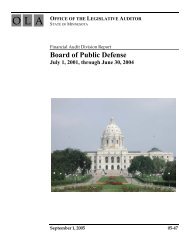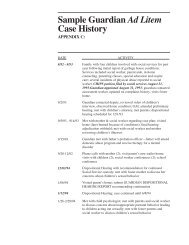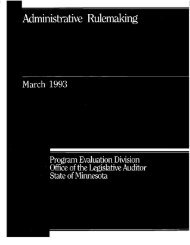Occupational Regulation - Office of the Legislative Auditor
Occupational Regulation - Office of the Legislative Auditor
Occupational Regulation - Office of the Legislative Auditor
Create successful ePaper yourself
Turn your PDF publications into a flip-book with our unique Google optimized e-Paper software.
ORGANIZATION OF OCCUPATIONAL REGULATION 31<br />
Table 2.2: Health-Related Board Finances (in Thousands), FY1998<br />
<strong>Occupational</strong><br />
Accumulated<br />
Direct Indirect Total Licensure Total Current Ending<br />
Board FTE a Expenditures Expenditures Expenditures Charges Revenue Differences Balance<br />
Chiropractic Examiners 4.75 $ 302 $ 172 $ 474 $ 498 $ 498 $ 24 $ 44<br />
Dentistry 7.0 654 275 929 1,173 1,173 244 537<br />
Dietetics and Nutrition Practice 1.0 77 20 97 130 130 33 228<br />
Examiners for Nursing Home<br />
Administrators 2.0 141 30 171 232 232 61 76<br />
Marriage and Family Therapy 1.6 93 17 110 100 100 (10) 32<br />
Medical Practice 23.0 3,431 243 3,674 3,518 3,518 (156) 610<br />
Nursing 29.0 1,603 939 2,542 2,695 2,695 153 472<br />
Optometry 1.0 74 16 90 99 99 9 92<br />
Pharmacy 11.0 790 94 884 876 876 (8) 44<br />
Podiatric Medicine 0.5 33 13 46 42 42 (4) 25<br />
Psychology 7.4 414 262 676 908 914 238 15<br />
Social Work 9.75 674 262 936 745 792 (144) 118<br />
Veterinary Medicine 1.75 173 84 257 301 301 44 87<br />
Emergency Medical Services<br />
Regulatory Board b 16.0 N/A N/A N/A N/A N/A N/A N/A<br />
Total (Health Boards) 115.8 $8,459 $2,427 $10,886 $11,317 $11,370 $484 $2,380<br />
NOTE: Financial data are in thousands <strong>of</strong> dollars. Most figures are estimates.<br />
a Number <strong>of</strong> employees in full-time equivalents.<br />
b The Emergency Medical Services Regulatory Board became effective July 1, 1996. Financial data are not yet available.<br />
SOURCE: Health Boards’ Administrative Services Unit.<br />
The boards are not directly financed by revenue from licensing or examination<br />
fees. They are financed through a biennial appropriation which is based on<br />
historic and projected fee revenue. In addition, appropriations are made to <strong>the</strong><br />
<strong>Office</strong> <strong>of</strong> <strong>the</strong> Attorney General for legal and investigative services for <strong>the</strong> boards.<br />
Each board is billed for services rendered. These amounts are included in <strong>the</strong><br />
board expenditure amounts presented in Table 2.2 along with all o<strong>the</strong>r indirect<br />
costs. Indirect costs include <strong>the</strong> contributions boards made to <strong>the</strong> Administrative<br />
Services Unit, and two programs established by Chapter 214, <strong>the</strong> HIV and HBV<br />
Prevention Program and <strong>the</strong> Health Pr<strong>of</strong>essionals Services Program. The<br />
HIV/HBV Prevention Program administers mandatory reporting and monitoring<br />
requirements for certain regulated pr<strong>of</strong>essionals infected with <strong>the</strong> human<br />
imunodeficiency virus (HIV) or <strong>the</strong> hepatitis B virus (HBV). The Health<br />
Pr<strong>of</strong>essional Services Program provides confidential services to health<br />
pr<strong>of</strong>essionals with a chemical dependency or certain o<strong>the</strong>r impairments. Nine<br />
boards participate in this program.<br />
The first column <strong>of</strong> Table 2.2 shows <strong>the</strong> full time staff employed by each board.<br />
The number <strong>of</strong> employees varies from 29 for <strong>the</strong> Board <strong>of</strong> Nursing to one for <strong>the</strong>








